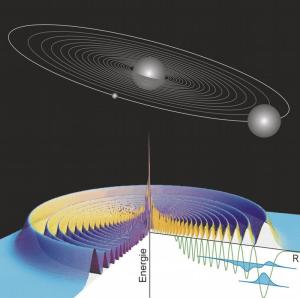|
Related Topics: |
|
|
|
Current News |
|
Chemistry A to Z |
|
About Internetchemistry |
Rydberg Molecules |
|
A rare Rydberg molecule discovered by scientists from the University of Stuttgart and University of Oklahoma upheld scientific theory predicting the molecule existed. The team used a gas of rubidium atoms cooled to a temperature of 3 millionths of a degree above absolute zero to produce the molecule. The longest-lived molecule produced by the team survived only for 18 microseconds. James Shaffer, professor in the OU Department of Physics, was part of the German-led team that made the recent discovery that some say demonstrates a ‘new’ type of bonding, which makes this molecule different from other Rydberg molecules. The electron scattering in this approach can be used as a benchmark test for future quantum calculations of atomic and molecular structure. |
|
Shaffer says a weak bond forms when an electron far from the nucleus and another ground state (normal) atom interact. The electron is slightly attracted to the ground state atom and vice versa. The electron pulls the ground state atom back toward the Rydberg atom just enough so it does not escape. The result is the rare Rydberg molecule like the one produced by the team in Germany. None of this could occur without the low temperatures obtained using laser cooling and trapping combined with the high-end density of the most advanced types of atom traps. These molecules are an important test for atomic theory which first emerged in 1934 when Enrico Fermi predicted how another atom might behave when interacting with an electron far from its nucleus. OU researchers are looking for the same types of molecules formed by Cesium atoms, but a Cesium atom is slightly different because there is more than one type of molecule depending on how the spins of the system align. This feature can be used to understand how the magnetic moments of the electron and atom interact. |
|
|
|

